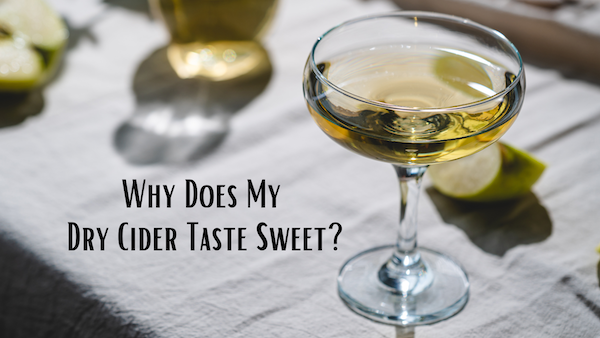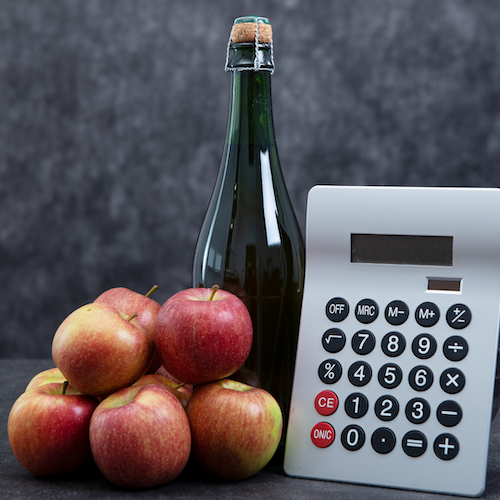Posts by Guest Contributor
Why Does My Dry Cider Taste Sweet?

Written by Tim Godfrey
Cider has long dealt with assumptions and misrepresentations of sweetness. In fact, the first reaction when folks are asked about cider often relates to the question of how sweet it is. Curiously, this happens in cases where the cider is actually quite dry, but is adamantly proclaimed as sweet. Why is this?
In the realm of tasting and sensory evaluation, the distinction between perceptive sweetness and residual sugar presents a captivating conundrum for Pommeliers, industry professionals, and even the average drinker. These terms, though seemingly interchangeable, unveil distinct concepts that significantly influence our sensory experience. Perceptive sweetness encompasses the remarkable interplay of our taste buds and olfactory receptors, enabling us to perceive sweetness in a cider despite the absence or minimal presence of residual sugar. It is an intriguing phenomenon that relies on the intricate complexities of sensory perception. Our brain’s ability to deceive us becomes apparent as taste and aroma interact, conjuring a perceptual illusion of sweetness, even in ciders with restrained residual sugar content. This phenomenon is typically attributed to three other sensory characteristics of cider: Aromatics, Acidity, and Alcohol.
Aromatics
Ciders contain a vast array of aromatic compounds derived from various sources, including the apples themselves, fermentation, and aging processes. Fruity aromas, such as those reminiscent of ripe apples, citrus or tropical fruits, or any added fruit to the cider can evoke associations with sweetness, that we generally term “fruitiness”. Even in the absence of substantial (or any) residual sugar, the presence of fruity aromas can trick our senses into perceiving a cider as sweeter than it actually is. The same is true of ciders aged in oak barrels, which can contribute flavors such as vanilla, caramel, or spices. These additional aromas interact with the fruit character and create a sense of sweetness on the palate even when no sugar is present. This is likely due to the close link between the olfactory receptors in our noses that perceive these fruity aromas, and the taste buds on our tongues that perceive sweetness. Knowing how something will taste based on how it smells is anatomically connected as well. The olfactory receptors perceive aromas through two pathways: directly through the nose – “orthonasal”, and through the back of our throat – “retronasal”. This is all to say that our sense memories of fruit as “sweet” is complicated by the anatomy of aroma perception, creating perceptive sweetness when sugar might not actually be present.
Acidity
Our taste buds perceive five basic tastes, all of which interact and counteract each other in differing, complex ways. Acidity and Sweetness are two of these that tend to have a counteracting relationship and are foundational in our perception of cider. Acid tends to provide a light, refreshing quality to cider, whereas sweetness contributes viscosity and body. Balance is achieved when these two sensations are in harmony, but given their counteractive nature, the interaction between sweetness and acidity can influence our perception of residual sweetness. For example, high acidity tends to mask or diminish the perception of sweetness, resulting in a lighter, crisp body, whereas ciders with low acidity and high residual sugar can result in a cloying, syrupy sweetness, and “flabby” body. An overly sweet cider can be “fixed” with the addition of acid and vice versa, but this can be hard to discriminate as a taster. In cases where it is unclear whether or not real sugar is present, rely on your tongue to feel the texture of the cider rather than the taste.
Alcohol
Frankly, at the regular ABV of most ciders (5-8%) alcohol does not seem to bring the same perceptive sweetness impact as it does in wine. However, it is well known that the presence of alcohol in wine can amplify the perception of sweetness, and that premise could still apply to cider to a degree. Alcohol stimulates our sweet taste receptors, intensifying our perception of sweetness even in the absence of substantial residual sugar. This interaction between alcohol and our taste buds creates an intriguing sensory experience that can deceive our palate. Alcohol also contributes to the overall balance and integration of flavors in cider. It adds body, texture, and warmth to the cider, complementing other sensory elements. When combined with residual sugar, alcohol can create a perception of sweetness that is greater than the actual sugar content would suggest. Alcohol’s impact on body and texture also influences the mouthfeel and viscosity of cider. Higher alcohol levels impart a fuller, more viscous texture, which is similarly experienced in sweet ciders. So while the impact of alcohol on perceptive sweetness may not be as exaggerated in cider as it is in wine, it undoubtedly still plays a role.
How do we overcome the mind games of perceptible sweetness versus residual sugar in cider? Consider these five tips when assessing a cider:
- Analyze the Label: Look for terms such as “dry” or “off-dry,” which indicate lower residual sugar levels. Style can also impact residual sweetness. If the cider was carbonated using a secondary fermentation, chances are it is dry. In some cases you might be able to consult the Nutrition Facts label, so take a look to see if the cider has added sugar.
- Assess Acidity: Evaluate the cider’s acidity level. Higher acidity levels can counterbalance residual sugar, resulting in a drier taste perception. Ciders with a pronounced acidic backbone are more likely to exhibit perceptive sweetness rather than substantial residual sugar.
- Evaluate Mouthfeel: Pay attention to the cider’s texture and viscosity. Ciders with a thicker or syrupy mouthfeel often correlate with higher residual sugar levels. On the other hand, ciders with a lighter and more refreshing mouthfeel are more likely to convey perceptive sweetness without significant residual sugar.
- Consider Alcohol Content: Take note of the alcohol level in the cider as indicated on the label. Higher alcohol concentrations can enhance the perception of sweetness. Even in the absence of residual sugar, ciders with elevated alcohol content may impart a perceived sweetness due to the stimulation of sweet taste receptors.
- Trust Your Palate: Ultimately, building a discerning palate takes time and experience tasting ciders. Keep on tasting! Looking for dry ciders to try? Check our our Dry Cider Directory!

Tim Godfrey has been involved in the cider industry for over ten years, making cider commercially in the Midwest as well as on the West Coast, and has volunteered for the American Cider Association since 2019. Tim currently works at Lake Michigan College in Benton Harbor, MI in the Wine and Viticulture Program, running the teaching winery and instructing enology coursework. He continues to stay involved in the cider industry through the ACA, as a consultant to startup and emerging cideries across the U.S. through his business Godfrey Beverage Solutions, and as a home orchardist and cidermaker. He is also a Certified Pommelier™.
A Few Tips for Getting the Most Out of Cider Market Data

We’re excited by the prospect of being able to provide both on-premises and off-premises syndicated data through our partnership with CGA & Nielsen IQ. With access to this data being a newer feature of ACA membership, we thought it prudent to go over a few concepts related to on and off-prem syndicated data.
Both on and off-prem sales statistics are measured using similar metrics including both dollars of cider sold and volume of cider sold. It’s important to remember that syndicated sales data such as this measures transactions from the retailer sold to the customer, not from the producer sold to the wholesaler or the wholesaler sold to the retailer. This data is always extrapolated from a smaller sample size to represent the larger market, so often the data is not an exact metric, but rather a gauge on overall trends.
In on-prem, this data represents sales from customers buying cider from bars, restaurants and venues. In the off-prem this data represents sales from customers buying cider at grocery stores, convenience stores and liquor stores. At first glance, the on-prem dollar sales are larger than off-prem sales for the trailing 52 weeks leading us to believe that the on-premises is where the majority of cider revenue is coming from. However, on-prem retailers sell our ciders at a very different price per gallon to their customers than do grocery stores. If you compare the volume of cider sold through on and off-prem, you can see that off-prem sells more than twice the volume as on-prem. Both on and off-prem data measures the volume of cider sold in Case Equivalents (24x12oz or 288oz). Syndicated data uses these case equivalents so that we can more easily compare volumes of cider sold regardless of whether sold in a keg or a can.
Be careful when comparing data between on and off-premises as both can be useful but it can be misleading if compared directly to one another without context and analysis. We hope this helps you to make better use of the data newly available to us.
You can find the on and off-premise data in our Resource Hub.
You must be an active ACA member to view the data. Not an ACA member? Join now!
Reflections on ACA’s Equity & Inclusion Training with Board Member Brooke Glover
I volunteer as Vice President of the Board of Directors of the American Cider Association (ACA) because I care deeply about the cider industry and appreciate that the Board is very involved and active in the ACA’s work and mission. As part of the ACA mission statement to create a diverse cider industry, and part of our commitment to antiracism we made back in June, the ACA recently hosted an equity and inclusion training for our Board of Directors on November 10th
Dr. J Jackson-Beckham, the principal at Crafted for All and a trusted advisor with the ACA, was tapped to lead the training on Building Foundations for Equity & Inclusion. During the training, Dr. J reminded us that we were in a safe space and that we needed to feel comfortable to ask questions and express ourselves freely without judgment. After a really funny icebreaker (what’s your superpower!?), she provided us with her definitions for Inclusion, Equity and Justice (you can find more on that through her Patreon account). Her reason for this was to ensure we had a shared language to use during the training. This became the basis for much of our conversation.
I left with a few takeaways from Dr. J’s training that I think will help guide the ACA toward continuing our important work in this space:
- Filling quotas is not the goal. Our goal is having a diverse industry and that is not attained by simply checking boxes nor will be attained overnight, as much as we want that to happen. To achieve our goal of a diverse industry we must have process and progress.
- Setting small goals over and over again will keep the organization (and our world) moving forward.
- We are beginning to set small goals to track mechanisms for progress and process by:
- Tracking the demographics of speakers at CiderCon
- Continuing to make it known that we want to be inclusive and that all are welcome
- Refining processes for board and committee member development
- Making tools available to members such as policy templates, signage, and job description example verbiage
- We need to continue to be supportive and understanding toward others. We are trying to grow an amazing and robust cider industry and we are all on the same team
- A diverse industry means encouraging all to be a part of the industry— including people who think differently from each other and come from different backgrounds
Lastly, Dr. J gave us some homework to do before we meet again in order to make sure we have action items that come out of the training. We had some amazing discussions over the course of our training and it helped me to think about progress, education, and setting small goals. The ACA and our members seem to be excited to continue to work toward these goals and our overall mission. I am very appreciative of the volunteer work of our Equity & Inclusion Committee and the support of our members. I look forward to growing together as we work toward our shared vision for the industry.
—Brooke Glover, Co-owner of Swilled Dog Cider and ACA Vice President
Ask a professor: Is it safe to order cider right now?
Anna Katharine Mansfield is an Associate Professor of Enology at the Cornell Craft Beverage Institute in Geneva, NY. We met Anna Katharine during the New York Cider Association’s Virtual Town Hall and followed up with some questions for our members about how to protect employees and customers from the novel Corona virus.
ACA: Is it safe to order cider for curbside pickup, delivery or online?
AKW: Yes! It’s safe, and it’s a great way to support your local cidery in a challenging time.
ACA: What is the best protocol for ensuring cideries are safely packing product for shipping or delivery with respect to the novel Corona virus? For our employees and for the product?
AKW: The good news is that you don’t need to do anything extra to ensure that your products are safe. COVID 19 is not an environmental pathogen, so continuing to follow routine cleaning and sanitizing protocols will eliminate and deactivate it. It’s also not a food-borne illness, so there’s no risk of it somehow getting into your cider and infecting a consumer. The greatest risk is person-to-person transmission, so employees within your facility should follow appropriate hand washing and social distancing protocols. It’s also a good idea to assess the high-traffic areas of your facility, like doorknobs and light switches, and clean them more frequently than you would normally; that will help prevent virus transmission if an employee is sick but asymptomatic. You can find a template for COVID 19 strategy protocols and a checklist of frequently-touched surfaces here: https://instituteforfoodsafety.cornell.edu/coronavirus-covid-19/risk-management-strategy-checklist/
ACA: How long does the virus live on cans? glass? cardboard?
AKW: We have no scientific data on aluminum or glass survival time, but do have data on cardboard, plastic, and stainless steel. In a highly-controlled lab environment, COVID 19 could be detected for up to 24 hours on cardboard, 48 hours on stainless steel, and 72 hours on plastic. It’s important to remember, however, that this experiment occurred under ideal circumstances for the virus- the surfaces were inoculated with a relatively high titer, and were protected from outside intervention. COVID 19 will not survive as well, or nearly as long, under the normal stresses of packaging and shipping. And while we don’t have experimentally-determined numbers for aluminum cans or glass, data from studies of other viruses suggests that detection times for aluminum will be similar to stainless steel, and glass will likely be less than that. COVID 19 doesn’t have extraordinary factors that would allow it to act differently than other known viruses.
ACA: Can someone contract COVID-19 from handling a packaged cider with the virus on it?
AKW: There is no evidence that COVID 19 can be transmitted via packaging, but for readers who are still nervous, we can walk through the hypothetical situation that would put a consumer at the most risk. A fictitious employee is sick, and coughs on the packaging, or wipes their nose and doesn’t wash their hands before touching the product, and manages to deposit a high concentration on the package. The consumer receives the package while the virus is still viable, touches it in exactly the spot where the virus was deposited, and then touches their own face without washing their hands. That’s a really tenuous chain of events, *all* of which have to happen- and there are several places where thoughtful intervention will break the chain. Sick employees shouldn’t be handling product; all employees should be washing their hands frequently; orders can be packed up and set aside for a time prior to pick up or delivery; and well-informed consumers are also washing their hands frequently. It’s quite a stretch, when you think of all the variables that have to line up just right.
ACA: What advice should cideries give customers to limit their risk?
AKW: If your product is distributed in exterior cardboard packaging, you can simply tell consumers to remove it and recycle it. The cans or bottles within the box will be perfectly safe. If they’re buying exposed cans or bottles, the best advice is to simply wash their hands after bringing products into the house. If they’re really concerned, they can wash the outside of the can or bottle with soap and water, but that’s not necessary- it’s just going too make them feel better. Letting them know that your employees are following appropriate cleaning and sanitizing protocols should help.
ACA: How do you ensure social distancing with deliveries and DTC online sales?
AKW: Your best bet is to have a plan in place ahead of time. Think through the steps that will happen with each delivery or sale, and figure out where social distancing risks may occur- then create protocols to avoid them. For instance, the person making the delivery can call ahead and arrange a place to leave the package so the consumer can pick it up without making direct contact. It’s wise to take payment remotely, via phone or internet, if at all possible. DTC consumers can call ahead to order, and pick up pre-packaged orders at the door or curb. With a little advance planning, social distancing should be easy.
ACA: Any other tips you want to share?
AKW: The most important thing to remember is that the danger lies in person-to-person transmission, not food borne or environmental transmission. All employees should be trained specifically in social distancing and proper hand washing techniques, and no one should come to work if they suspect that they’re ill. A rapidly growing list of FAQs and resources can be found at the Institute of Food Safety’s COVID 19 page: https://instituteforfoodsafety.cornell.edu/coronavirus-covid-19/food-industry-resources/

COVID Resources for Canadian Cideries

Hello! This is Kristen Needham Jordan from Sea Cider in British Columbia, Canada. American Cider Association has asked me to compile COVID Crisis information for the benefit of the ACA’s Canadian members, so here goes…
I’m sure I have met many of you over the years at CiderCon, Cider Summits or cider events in Canada. For those who don’t know me, I am the owner/operator of a small orchard-based cidery on Vancouver Island called Sea Cider. The COVID Crisis has hit Sea Cider hard, in several different ways, and while we are seeing an increase in sales through our online store, the overall impact has been a huge hit to our revenue and ability to cover our operating expenses.
Here are some parts of our COVID Crisis Plan:
- The goal of our crisis management plan is to improve Sea Cider’s “cash on hand” position as quickly as possible. Financial support from lenders will work in tandem with other crisis management measures Sea Cider is taking to “weather this storm” and position ourselves to bring business back up to normal levels once the health crisis has passed.
- Since sales through our Tasting Room, event sales, farmers markets, keg sales and all US sales have all stopped, we are focusing our sales & marketing efforts on our two remaining revenue streams: direct-to-consumer online sales, and bottle wholesales within BC. We have laid off some staff, significantly reduced hours for production staff, switched to work at home for sales and administrative staff and are pursuing the following supports that have been announced in Canada:
Federal Government Support
- GST remittances can be deferred until June
- Launch of a special emergency business account for small businesses that will see banks offer $40,000 government-guaranteed loans interest-free for the first year. If certain conditions are met, the first $10,000 will be forgiven.
- Friday morning, the Bank of Canada announced an unscheduled interest rate cut, slashing the key interest target by half a percentage point to 0.25 per cent
- Temporary Small Business Wage Subsidy – Will calculate 75% of payroll for the effective period (up from the 10% announced a week ago), back dated March 15th, which is subtract from the payroll remittance payment for the period: https://www.canada.ca/en/revenue-agency/campaigns/covid-19-update/frequently-asked-questions-wage-subsidy-small-businesses.html
- Work Share Program (for temporary business down turn): https://www.canada.ca/en/employment-social-development/services/work-sharing.html
- The Canada Emergency Response Benefit (CERB), which will provide $2,000 a month for up to four months for workers who lose their income as a result of the COVID-19 pandemic. Learn more at https://www.canada.ca
Provincial Government of BC Support (*Note from Michelle: Do you have information about your province? Let us know–we’re happy to share here).
- Health tax payments will be deferred until Sep 2020 with no penalties or interest:
- PST payments will be deferred until Sep 30 2020
- WCB Premium payments are being deferred
- Rental support of $500/month that individuals may access if they are tenants
Banks and Lenders
- Farm Credit Canada is setting in place both emergency lending and Interest payment deferral for farms with existing loans
- Commercial banks, such as RBC and TD, are supposed to be offering interest payment deferrals, but credit limits have not been loosened so this may be difficult for companies to access who are already max’d out
Other Suppliers
- BC Hydro is allowing businesses to defer payments. Contact them when your next bill arrives so your payment isn’t automatically processed from your bank account.
- Finally, we have been talking to some of our key suppliers to stretch out payments
Other Useful Links
- Canada’s COVID-19 Economic Response Plan: Support for Canadians and Businesses
- https://covidcontinuity.com/
Good luck out there, and stay safe ~
In cider,
–Kristen.
Cider And Cheese Pairings For Any Occasion
A technique review in honor of #WineAndCheeseDay
It’s a perfect summer morning in the Pacific Northwest. As I stroll into work my mind wanders. Stopping for a shady moment under an apple tree heavily weighted with delicious glowing orbs I am suddenly struck with the desert island question. What drink would I take with me? Cider definitely. Ooh, and cheese too! But, which cheese with which cider?! I could be on this island a long time. I need to get it right.
While cheese and cider can never really be wrong in my mind, there are a few basic techniques to help you to choose pairings that will bring out the best qualities in both the cider and the cheese. Please understand that these are techniques to help guide you and that there will always be exceptions that may not be the best pairings.
● Match intensity: Align intense ciders with intense cheeses and mild cheese with less intense cider. Intensity in food and cider refers to its mouthfeel, which depends on things such as sugar, acid, salt, spice, etc. We get the classic ice cider and blue cheese pairing from this technique.
● Terroir Matching: “If it grows together it goes together.” Sometimes the cheese and the cider are even from the same farm.
● Complement: Pair similar aromas and flavors in both the cider and the cheese.
● Cut: Use the acidity of a cider to cut through the fat of the cheese.
Using these methods, you can take any cider no matter its perceived elegance and create a cheese pairing that is excellent for any occasion.
For an evening of camping, grab yourself a 6-pack of canned berry-forward cider and a creamy mild cow’s milk cheese to savor a deliciously uncomplicated match.
If an evening in with friends is on the agenda, maybe a large-format, bottle-conditioned, tannin-forward cider would be better suited. Accompany it with an aromatic sheep’s milk cheese ideally from the same growing region.
For more advanced cider and cheese pairings we call upon the building blocks of creating taste balance. Balance in intensity as well as balance across the palate, essentially creating the perfect swish, bite and swish.
- Contrast: This pairing is designed to stimulate and intrigue the palate. You are looking for opposing flavors and aromas.
- Complete: Either the cider or the food to complete or fill in any of the 5 main tastes (sweet, sour, bitter, salty and umami) that either the cider or the food does not already contain.
By starting with basic pairing techniques, you are now well equipped to experiment. Don’t be afraid to put your palate to the test and try adding unique ingredients to both contrast and complete both the cider and the cheese. These can include fresh herbs, dried fruits, local honey, nuts, edible flowers or locally grown fresh fruits.
Here’s an advanced example using both techniques: pair baked brie topped with fresh maple syrup and crispy bacon crumbles with a sparkling tannin-forward cider. Score even more points if the bacon came from a pig that grazed in the same orchard where the cider was produced.
To review, these techniques will help you create amazing cider and cheese pairings: match intensity, terroir matching, complement, cut, contrast, complete. Follow these basic guidelines and your cider and cheese pairing will be the perfect match for any occasion.
Author Jennie Dorsey is the Chief Cider Curator of Schilling Cider House PDX, a member of American Cider Association’s Certified Cider Professional Working Group, and a founding member of the Pomme Boots Society.
Photo by Alli Fodor.





